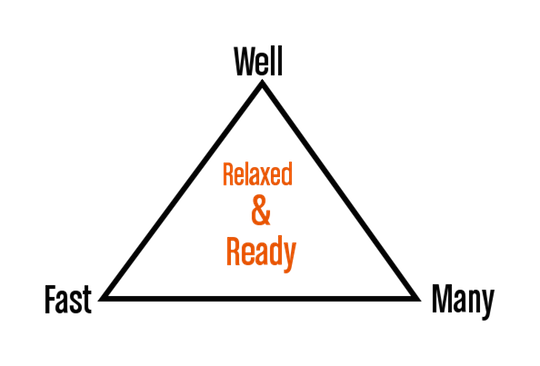“Do few things but do them well.”
-Donovan
I overestimate myself. Turns out, I am not the only one.
Early on in my career, I learned that if I expected everything to go according to an ideal estimate, I would often end up with a mess. The “Pick Any Two” model of project management explains why it is simply not possible to “have it all” in a large, complex undertaking.
Life, by the way, is a large, complex undertaking that is also time-bound (though we don’t know by how much until it is over). Hence the advice to “Do few things but do them well.” That is one option, but it is not the only option. I have teased out the dynamics of the “Pick Any Two” model specifically for my own knowledge work. It looks like this:

The idea is that:
- I can do things fast, and do many of them, but clearly the quality will suffer
- I can do things fast and well, but not very many of them at once
- I can do things well, and do many of them, but need a lot of time to do so
- If I try to satisfy all three parameters at once, my ability to remain relaxed and ready will suffer. It is, in fact, a guaranteed way to make myself tired and stressed.
Generally speaking, the “fast and well” approach most closely aligns with my own value system. It also helps to minimise the “switching cost” that I detailed in another article.
However, it is sometimes simply not possible to do few things fast and well. When I am not in control of volume (how many), or timeline (how fast), then I have to recognise that my own quality standards may not be met. By bearing this model in mind, however, I make this a conscious (rather than unconscious and perhaps resentful) choice to cooperate with reality, and adjust accordingly.
So how are you doing with your own fast / well / many equation? Are there parameters to adjust to maintain a relaxed and ready state?
If you are practicing the GTD methodology, you have a pretty good picture of how many things you have committed to doing via your project and next action lists. You also have some sense of available time to execute on these commitments by looking at the “white space” in your calendar—the places where you are not booked in a meeting or other time-specific commitment. In my experience, those meetings are generally about alignment, not actual execution time.
What remains is quality—your own standards, and the standards you have agreed upon with those around you. Because a certain level of quality is often non-negotiable, practicing the twofold art of first being very careful about taking on new commitments, and then renegotiating as necessary (using the “Three R’s” I mention in another article), can ensure you are making the right trade-offs in your work and life.
I can’t have it all, and sometimes I overestimate myself by trying. Learning to live within the dynamics of this cold, hard reality has actually been one of the greatest contributors to a warm, fuzzy sense of happiness. My hope in sharing it is that it might lead you that much more in the direction of your own satisfaction.
Pick any two. Then have fun.

